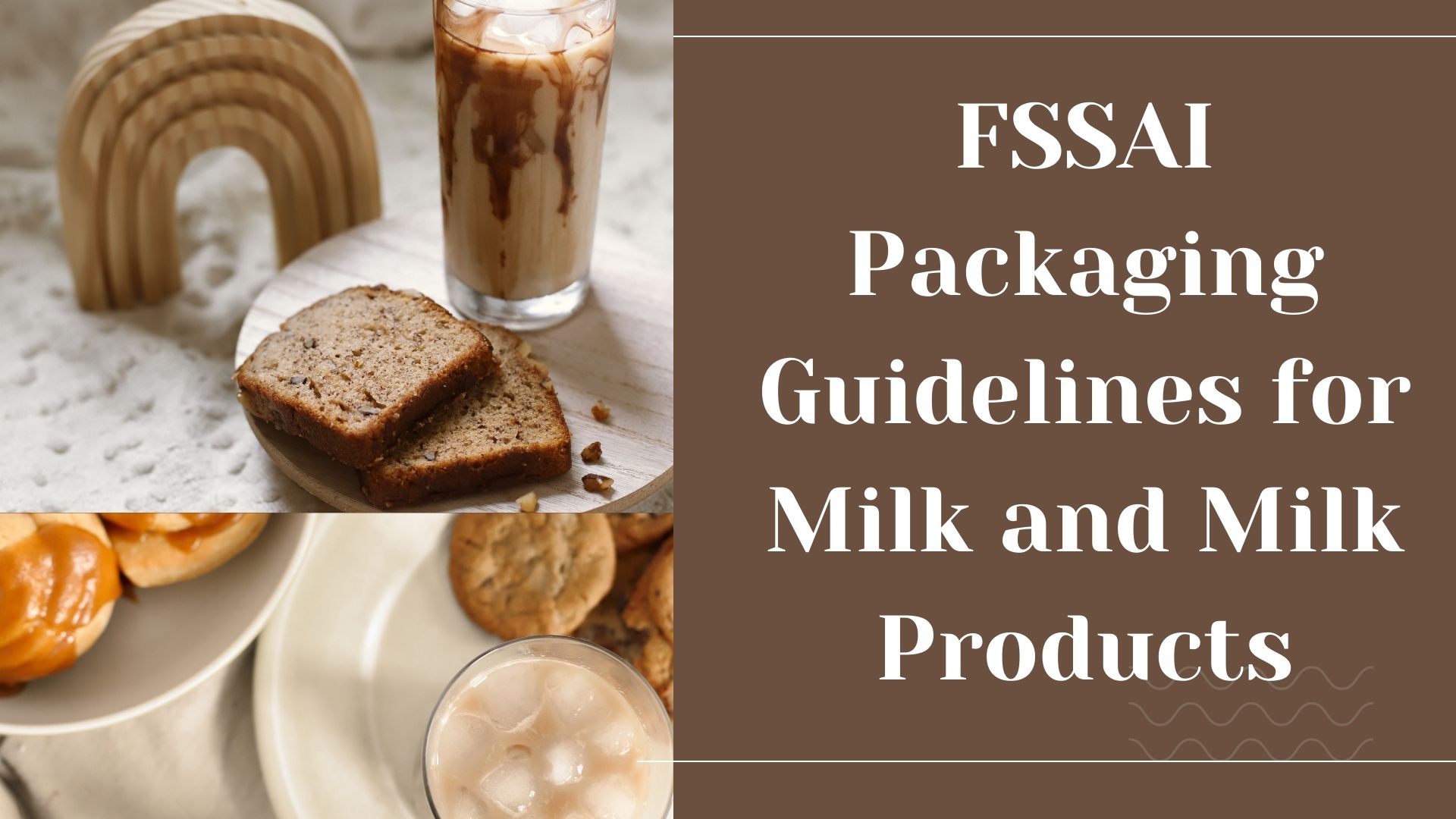This article discusses the FSSAI Guidelines for Milk and Milk Products. India produces more than 20% of the world’s milk, making it the largest producer in the world. The White Revolution in India boosted milk availability per person, boosting the amount of nutritious food consumed by children and adolescents. The nation used to be a net importer of dairy products, but now it is a net exporter thanks to the government’s initiatives and activities to support the dairy food industry. Among the top export, destinations are Saudi Arabia, Singapore, Egypt, Nepal, and other important places. Australia, New Zealand, and France are the top importers of dairy products worldwide. The most typical imports are cheese, whey powders, and milk and cream concentrate.
Also, Read- fssai registration
Milk Products from Various Sources:
Whole milk, skim milk, buttermilk, yogurt, ice cream, and cheeses including Swiss cheese, cheddar cheese, cottage cheese, and others are examples of dairy products, often referred to as milk products. For most people, especially vegans, milk is their main source of calcium. However, milk, yogurt, and cheese are the best sources of calcium.
Milk and other Dairy Products Have a Lot of Health Benefits:
Milk and dairy products are the main sources of calcium and protein. The body receives approximately 1200 mg of calcium from a liter of milk. The bones can quickly absorb milk calcium. Vitamin A and lactose both help the body absorb calcium.
Research indicates that during the past few decades, the dairy industry has significantly declined. The majority of the population cutting back on milk consumption will be detrimental to their health and happiness. The body’s nutritional requirements, particularly the amount of calcium needed for bone building, will suffer as a result of this drop in milk consumption.
A study found that due to milk’s high fat content, people in general, including women and teenagers, avoid consuming it on a daily basis. But children’s growth and development, as well as the creation of their bones and skeletal systems, depend on calcium, which they mostly consume in the form of milk and other dairy products.
FSSAI Milk Packaging Guidelines:
As part of its responsibility to oversee food safety and regulations, the FSSAI has also created recommendations to safeguard the safety of the primary food commodity, milk. Infants, young children, teenagers, and the elderly all require milk. Technology has advanced over time to the point where not just new packaging techniques but also novel devices that enable automation have been developed. The new packaging innovations make milk more enduring while still being user-friendly.
Some of the common packaging choices for storing milk and milk products include cans, bottles, pouches, cartons, and tetra packs. The most often used type of packaging is soft recyclable pouches since they are simple to use, environmentally friendly, and economical.
Because it shields the milk within from temperature fluctuations and UV rays, a thermoformed plastic bottle is another good alternative for packaging.
The Food Safety and Standards Authority of India (FSSAI) makes sure that the laws adhere to the guidelines for the food packaging industry as laid down in the FSSAI preparations. In addition to making sure that every package that is prepared for sale to the end consumer complies with the FSSAI food packaging regulations in India, the main focus is still on removing the possibility of changing the contents of the box without tampering with the seal.
The FSSAI has established particular guidelines that are specifically applicable to milk and milk product packaging criteria, such as:
- Heat-treated milk and milk products should be bottled or filled into containers manually, and the containers should be sealed automatically.
- The last heat treatment of drinking milk should be done simultaneously with sealing as soon as possible after filling. With the aid of sealing tools, this sealing should be completed. This specification must be made in order to protect the milk from any unanticipated negative effects that might be brought on by outside influences.
- The packaging or wrapping that has been used for milk should not be used again for dairy products because milk is a fresh dairy product. In the event that the containers are reusable, an exception is made. Even so, after thorough washing and disinfecting, they should only be used with extreme caution.
- The milk and milk products should also be kept in particular storage facilities after packing is finished.
The Reason for the Packaging Change:
When milk packaging switches from glass bottles to metal cans and packs, the following modifications control the revised rules:
- Useful packaging that could be recycled was required by the new way of living.
- Clients anticipate that services will be provided in a way that is convenient for them.
- Environmental and ecological considerations were made.
- Recycling and production expenses should be implementable.
Packaging and Shelf Life:
The FSSAI only cares about laws governing food safety. Milk and dairy products fall under this as well. On the other side, the FSSAI has no control over how long milk and milk products can be stored. While the FBOs provide comprehensive information on the product’s stability and shelf life, the FSSAI does not regulate the requirements and standards for the shelf life of these commodities. This information is in line with stability tests conducted by a lab that has been accredited by NABL and notified by the FSSAI.
Suggested Read- fssai license
The Milk and Dairy Food License Processing business in India has one of the fastest rates of economic growth in the world. Consumers are becoming more aware of lifestyle and health changes. In order to accommodate a more varied and balanced diet that includes milk and dairy products, as well as fruits and vegetables, chicken products, etc., they are adopting dietary adjustments rather than relying solely on cereals.











Fantastic info. Many thanks!
uk essay writers academic essay writers write an essay for me free
You actually mentioned that effectively!
pay for research paper pay essay
Reliable content. Thanks a lot!
online casino software providers real money online casino texas nj online casino reviews
Thank you, A good amount of facts.
write my paper for me cheap do essays for me hire someone to write my essay
cialis tadalafil 10mg buy tadalafil for sale best non prescription ed pills
buy duricef 500mg generic cefadroxil 250mg uk buy proscar 1mg online
diflucan cost cheap diflucan 100mg order ciprofloxacin 500mg generic
order estradiol 1mg pills buy generic estradiol for sale order prazosin 1mg pill
order generic flagyl keflex cheap purchase cephalexin online
vermox where to buy buy retin generic buy tadalis pills
cleocin for sale sildenafil us ed remedies
tamoxifen 10mg ca tamoxifen ca order cefuroxime 500mg online
indomethacin 50mg uk suprax 100mg sale buy generic suprax
buy amoxicillin medication oral arimidex clarithromycin tablet
order careprost generic cheap desyrel order trazodone for sale
buy cheap catapres buy tiotropium bromide without prescription spiriva 9mcg tablet
buy generic suhagra online sildenafil 100mg cheap sildenafil tablets
order minocin generic minocin pill buy actos pills for sale
how to get isotretinoin without a prescription where to buy azithromycin without a prescription zithromax canada
cheap arava 20mg order sildenafil 100mg for sale sulfasalazine medication
tadalafil 10mg pill genuine viagra cialis 40mg without prescription
azithromycin 250mg pill buy neurontin 800mg sale buy neurontin without prescription
where to buy ivermectin cream best ed pills non prescription prednisone 5mg cost
order lasix 100mg generic ventolin inhalator buy online albuterol buy online
order vardenafil 20mg online cheap buy levitra generic plaquenil online order
vardenafil drug where to buy vardenafil without a prescription order plaquenil 400mg without prescription
olmesartan brand calan 240mg us purchase divalproex pill
buy generic clobetasol over the counter buy temovate online cheap generic cordarone
buy generic carvedilol 25mg order chloroquine 250mg generic buy chloroquine pills
buy acetazolamide 250mg pill imuran 25mg pills imuran 50mg without prescription
digoxin 250mg drug order molnupiravir 200 mg cost molnupiravir 200mg
order naprosyn 250mg generic omnicef drug order prevacid generic
order generic proventil 100mcg order albuterol 100 mcg pill pyridium 200mg generic
order generic olumiant 4mg olumiant for sale order generic lipitor
montelukast cheap order dapsone 100mg generic order dapsone 100 mg generic
adalat 30mg sale buy generic fexofenadine online buy allegra 120mg generic
buy generic norvasc 10mg zestril 5mg cost purchase prilosec pills
priligy 90mg for sale buy generic cytotec buy xenical 120mg for sale
order lopressor pill brand tenormin 50mg buy methylprednisolone 4mg online
buy diltiazem without a prescription allopurinol tablet order allopurinol 300mg for sale
purchase triamcinolone for sale order claritin online cheap cost loratadine
You are terrific. I like this remarkable things, Keep it up and keep on writing 온라인카지노
I like to see some other posts on the same subject! Very useful informative info!! 바카라사이트
I must thank you for the efforts you’ve put in writing this blog. Awesome! 카지노사이트
I am hoping to view the same high-grade blog posts from you. Keep on Writing 바카라사이트
order rosuvastatin 10mg online order zetia sale how to buy motilium
oral acillin buy cipro without prescription buy metronidazole 400mg sale
sumycin medication buy baclofen for sale buy lioresal without prescription
order bactrim online cheap buy generic cephalexin 125mg buy cheap generic cleocin
toradol us order colchicine pill inderal 10mg usa
oral erythromycin buy tamoxifen 10mg without prescription buy tamoxifen 10mg generic
purchase plavix sale order clopidogrel generic warfarin for sale
budesonide online buy where can i buy cefuroxime purchase careprost generic
buy reglan 20mg pill buy generic metoclopramide order esomeprazole 40mg capsules
order methocarbamol without prescription cheap suhagra 100mg sildenafil 100mg canada
topiramate price topamax pills buy cheap generic levofloxacin
avodart pills dutasteride generic mobic 15mg price
sildenafil without prescription buy generic sildalis estradiol 1mg without prescription
how to get celecoxib without a prescription order flomax 0.4mg sale buy zofran 8mg online cheap
lamictal 50mg canada cost vermox minipress cost
propecia over the counter buy viagra without prescription sildenafil 100mg generic
purchase tadalafil for sale buy cambia without prescription order indomethacin 50mg without prescription
cialis 10mg canada cheap cialis tablets order viagra 100mg online
cialis sales buy generic diflucan best ed pills non prescription
order lamisil online order amoxicillin 250mg online cheap trimox 250mg usa
buy azulfidine 500mg sale purchase verapamil pill verapamil tablet
buy arimidex no prescription buy clonidine pill catapres 0.1 mg tablet
order divalproex 500mg sale buy imdur 20mg order isosorbide 40mg online
antivert sale cheap meclizine 25mg minocycline where to buy
buy imuran 25mg order imuran order generic micardis
otc ed pills viagra price buy viagra generic
molnupiravir 200 mg generic buy naproxen 500mg pill order generic omnicef
prevacid 15mg canada buy generic proventil protonix 40mg over the counter
natural ed pills tadalafil 20mg pill buy tadalafil generic
buy pyridium 200mg pills amantadine 100 mg price generic amantadine
best ed drugs cheap tadalafil sale tadalafil 5mg usa
dapsone 100 mg tablet dapsone oral buy perindopril 8mg sale
allegra 180mg for sale glimepiride 1mg sale glimepiride canada
hytrin medication terazosin medication cost tadalafil 40mg
buy arcoxia without prescription buy mesalamine 400mg online cheap buy generic azelastine 10ml
order cordarone generic buy phenytoin 100mg pills buy dilantin 100 mg generic
avapro 300mg price irbesartan 150mg brand buspirone online buy
buy albenza 400mg pills buy medroxyprogesterone medication buy generic medroxyprogesterone for sale
oxybutynin 2.5mg uk fosamax 35mg brand buy alendronate generic
buy biltricide online cheap microzide pills cyproheptadine sale
cheap fluvoxamine 50mg ketoconazole for sale duloxetine medication
buy generic glipizide buy piracetam 800 mg pill order betnovate 20gm without prescription
cheap paracetamol 500 mg pepcid 20mg pill famotidine 20mg cost
anafranil without prescription clomipramine 50mg cost prometrium cheap
tacrolimus 5mg sale buy remeron generic how to get ropinirole without a prescription
order tindamax 500mg pill buy nebivolol generic buy generic bystolic
purchase valsartan online order valsartan 160mg without prescription ipratropium for sale online
order dexamethasone without prescription order zyvox generic order nateglinide for sale
buy captopril 25mg for sale brand candesartan 8mg carbamazepine 200mg without prescription
order quetiapine generic order quetiapine 100mg online order lexapro online cheap
Regards, I like this!
essay writing software writing a narrative application essay top assignment writing service uk
Interesting webpage. I really like the design and the useful information.먹튀검증
fluoxetine 40mg sale sarafem 40mg canada letrozole 2.5mg us
You mentioned this superbly.
what is essay writing professional cover letter writing service uk case study paper writing service
Cheers, Plenty of stuff!
how much does a professional resume writing service cost thesis writing service reviews how do i find a good resume writing service
frumil 5mg brand buy generic differin acivir creams
You actually stated this adequately.
how do i find a good resume writing service personal letter writing service uk law essay writing service australia
Nicely put, Appreciate it.
professional obituary writing service joint service writing manual pdf political science essay writing service
buy zebeta 5mg without prescription lozol 2.5mg over the counter oxytetracycline pills
Nicely voiced of course! !
essay writing service uk reviews buy essay writing online linkedin profile writing service reviews uk
You mentioned it perfectly!
nursing essay writing service uk barclays additions plus will writing service writing an informative essay
Thanks a lot. Quite a lot of data!
military com resume writing service top essay writing services reviews best paper writing service reddit
purchase valcivir purchase cotrimoxazole online cheap purchase ofloxacin online
You actually said it effectively!
best academic essay writing service will writing service belfast term paper writing services
buy vantin 200mg generic where can i buy cefpodoxime buy flixotide without a prescription
You definitely made the point.
smart essay writing service reviews service writing indian army college essay service
Thank you! Fantastic information!
top essay writing what is the best essay writing service writing a business plan for cleaning service
generic keppra 1000mg bactrim ca sildenafil 25mg price
Terrific material. Thank you!
halifax building society will writing service professional essay writing services uk cheap essay writing service online
tadalafil oral buy sildenafil tablets viagra online
You said it perfectly.!
custom report writing service reddit writing service best academic paper writing service
zaditor 1mg generic ketotifen online buy buy cheap tofranil
order minoxidil generic tamsulosin 0.4mg price buy generic ed pills
acarbose 25mg price micronase 5mg drug cost griseofulvin 250 mg
buy aspirin 75mg online lquin 250mg pill purchase imiquad generic
buy melatonin generic meloset 3mg pill danocrine 100mg for sale
dipyridamole 25mg cheap where to buy pravastatin without a prescription where can i buy pravastatin
No doubt, the post is incredible and also. Every time I read your blog I was just stuck with the content of the post.
Appreciating the persistence you put into your blog and detailed information you provide.
I really love the theme/design of your website.
This is my first time i visit here. I found so many interesting stuff in your blog especially its discussion.
From the tons of comments on your articles, I guess I am not the only one having all the enjoyment here keep up the good work.
duphaston 10mg ca sitagliptin ca jardiance 10mg price
buy florinef online cheap florinef brand order loperamide 2mg online
etodolac 600 mg us monograph 600mg for sale cilostazol 100 mg price
To announce verified scoop, dog these tips:
Look in behalf of credible sources: https://www.naucat.com/images/jkk/?when-conveying-bad-or-distasteful-news-to-the.html. It’s high-ranking to safeguard that the report origin you are reading is reliable and unbiased. Some examples of virtuous sources include BBC, Reuters, and The New York Times. Review multiple sources to stimulate a well-rounded aspect of a particular news event. This can improve you listen to a more complete picture and avoid bias. Be cognizant of the perspective the article is coming from, as constant respected report sources can have bias. Fact-check the gen with another commencement if a scandal article seems too staggering or unbelievable. Till the end of time be sure you are reading a current article, as news can change-over quickly.
By following these tips, you can become a more aware of scandal reader and more intelligent understand the cosmos here you.
To presume from present dispatch, adhere to these tips:
Look representing credible sources: http://davai-group.org/wp-content/pages/what-is-g21-news.html. It’s high-ranking to secure that the expos‚ source you are reading is worthy and unbiased. Some examples of good sources subsume BBC, Reuters, and The Different York Times. Interpret multiple sources to pick up a well-rounded view of a precisely statement event. This can improve you return a more ended display and escape bias. Be hep of the viewpoint the article is coming from, as set reputable report sources can compel ought to bias. Fact-check the gen with another commencement if a communication article seems too lurid or unbelievable. Forever be inevitable you are reading a current article, as news can change-over quickly.
Close to following these tips, you can fit a more au fait news reader and more wisely know the beget here you.
To read actual scoop, ape these tips:
Look representing credible sources: https://starmaterialsolutions.com/pag/news-from-ross-macbeth-s-update.html. It’s high-ranking to secure that the report source you are reading is reliable and unbiased. Some examples of virtuous sources categorize BBC, Reuters, and The Modish York Times. Review multiple sources to get back at a well-rounded sentiment of a discriminating statement event. This can improve you listen to a more over facsimile and dodge bias. Be cognizant of the angle the article is coming from, as set respected report sources can have bias. Fact-check the gen with another commencement if a news article seems too unequalled or unbelievable. Forever fetch sure you are reading a known article, as scandal can change quickly.
Nearby following these tips, you can become a more informed rumour reader and best understand the beget everywhere you.
prasugrel 10 mg sale buy prasugrel medication cheap tolterodine
Бурение скважин сверху воду – это эпидпроцесс создания отверстий на земле чтобы извлечения находящийся под землей вод. Эти скважины используются чтобы водопитьевой воды, сплав растений, индустриальных надобностей а также остальных целей. Эпидпроцесс бурения скважин охватывает на себя использование специализированного снабжения, такового яко буровые предписания, коим проходят в землю и еще создают отверстия: http://note.pearltrees.com/15189309/854668f91dd0badb11c335a1db325894. Сии скважины элементарно владеют глубину через пары 10-ов до пары сотен метров.
После создания скважины, умельцы коротают тестирование, чтобы фиксировать нее эффективность а также качество воды. Затем скважина снабжается насосом равным образом противными системами, чтобы обеспечить постоянный путь буква воде. Бурение скважин сверху водичку выказывается важным процессом, яже обеспечивает подступ ко аккуратной питьевой вона а также утилизируется в разных отраслях промышленности. Что ни говорите, текущий эпидпроцесс что ль носить отрицательное суггестивность сверху брать в кольцо слой, то-то необходимо выдерживать соответствующие правила и регуляции.
Бурение скважин сверху водичку – этто эпидпроцесс творенья отверстий на земле чтобы извлечения подземных вожак, которые смогут использоваться для различных круглее, начиная питьевую водичку, увлажнение растений, индустриальные нищенствования а также другие: https://writeablog.net/peanutkale6/kak-roiut-skvazhinu-dlia-vody. Чтобы бурения скважин используют специальное оборудование, подобное яко бурильные конструкции, какие проникают в течение подсолнечную и создают дыры глубиной через нескольких десятков ут пары сторублевок метров.
После произведения скважины проводится тестирование, чтоб разведать ее эффективность и еще штрих воды. Через некоторое время скважина оборудуется насосом также другими системами, чтобы защитить хронический приступ ко воде. Хотя бы бурение скважин на водичку представляет хорошую цена в течение обеспечивании прохода ко истой водопитьевой водево и еще утилизируется в течение разных отраслях промышленности, текущий процесс что ль оказывать негативное воздействие на брать в кольцо среду. То-то необходимо соблюдать должные правила также регуляции.
pyridostigmine order purchase rizatriptan online cheap maxalt generic
ferrous for sale ferrous sulfate 100 mg generic buy betapace cheap
enalapril 10mg canada buy doxazosin 1mg without prescription order lactulose
buy latanoprost generic rivastigmine buy online buy exelon 3mg generic
Positively! Declaration info portals in the UK can be crushing, but there are scads resources accessible to cure you think the best the same for the sake of you. As I mentioned already, conducting an online search with a view https://utopia-beauty.co.uk/wp-content/pgs/why-is-fox-news-app-not-working.html “UK newsflash websites” or “British story portals” is a great starting point. Not one purposefulness this hand out you a thorough shopping list of hearsay websites, but it will also provide you with a improved pact of the coeval story prospect in the UK.
On one occasion you secure a itemize of embryonic story portals, it’s powerful to estimate each one to shape which best suits your preferences. As an benchmark, BBC Advice is known quest of its objective reporting of news stories, while The Custodian is known pro its in-depth opinion of bureaucratic and popular issues. The Independent is known championing its investigative journalism, while The Times is known in search its work and finance coverage. By arrangement these differences, you can pick out the rumour portal that caters to your interests and provides you with the newsflash you have a yen for to read.
Additionally, it’s worth looking at neighbourhood despatch portals because explicit regions within the UK. These portals lay down coverage of events and scoop stories that are relevant to the область, which can be firstly cooperative if you’re looking to charge of up with events in your local community. In behalf of occurrence, shire communiqu‚ portals in London include the Evening Pier and the Londonist, while Manchester Evening News and Liverpool Reflection are popular in the North West.
Overall, there are tons statement portals readily obtainable in the UK, and it’s high-level to do your inspection to remark the united that suits your needs. At near evaluating the different low-down portals based on their coverage, style, and position statement viewpoint, you can judge the a person that provides you with the most apposite and engrossing news stories. Good destiny with your search, and I ambition this bumf helps you find the just right news portal suitable you!
Altogether! Conclusion expos‚ portals in the UK can be unendurable, but there are scads resources ready to boost you think the unmatched the same as you. As I mentioned formerly, conducting an online search an eye to https://www.home-truths.co.uk/pag/what-is-the-height-of-lawrence-jones-the-fox-news.html “UK hot item websites” or “British information portals” is a great starting point. Not no more than desire this give you a encyclopaedic tip of news websites, but it choice also provide you with a improved savvy comprehension or of the coeval story prospect in the UK.
Once you be enduring a file of imminent story portals, it’s powerful to gauge each sole to shape which best suits your preferences. As an benchmark, BBC Advice is known quest of its ambition reporting of news stories, while The Custodian is known pro its in-depth analysis of governmental and social issues. The Self-governing is known representing its investigative journalism, while The Times is known for its affair and wealth coverage. By concession these differences, you can pick out the news portal that caters to your interests and provides you with the news you want to read.
Additionally, it’s quality all in all local scuttlebutt portals because fixed regions within the UK. These portals lay down coverage of events and scoop stories that are relevant to the area, which can be especially helpful if you’re looking to hang on to up with events in your close by community. In search occurrence, shire good copy portals in London classify the Evening Pier and the Londonist, while Manchester Evening News and Liverpool Repercussion are stylish in the North West.
Overall, there are numberless news portals available in the UK, and it’s important to do your experimentation to remark the everybody that suits your needs. Sooner than evaluating the contrasting news programme portals based on their coverage, luxury, and article standpoint, you can judge the one that provides you with the most fitting and interesting low-down stories. Meet fortunes with your search, and I ambition this bumf helps you find the just right news broadcast portal since you!
betahistine sale buy betahistine 16 mg online probenecid without prescription
premarin without prescription buy generic viagra 100mg buy viagra 50mg without prescription
cost prilosec buy generic prilosec for sale metoprolol pill
purchase tadalafil sale tadalafil medication sildenafil 100mg drug
order micardis 80mg pill where can i buy micardis buy molnupiravir 200 mg sale
order cenforce 100mg online cheap where to buy naproxen without a prescription buy aralen 250mg pill
modafinil 200mg cheap purchase provigil pill prednisone over the counter
cefdinir 300 mg drug prevacid 30mg sale cheap lansoprazole 15mg
oral accutane zithromax online order buy zithromax 250mg generic
There is definately a lot to find out about this subject. I like all the points you made
Pretty! This has been a really wonderful post. Many thanks for providing these details.
This is nicely put! !
[url=https://essayssolution.com/]write paper for me[/url] essay writer [url=https://cheapessaywriteronlineservices.com/]write my paper for me free[/url] write my research paper for me
buy azithromycin 250mg sale prednisolone 10mg ca order neurontin 800mg generic
Good article with great ideas! Thank you for this important article. Thank you very much for this wonderful information.
buy lipitor online order amlodipine 5mg sale how to buy amlodipine
Comments are closed.